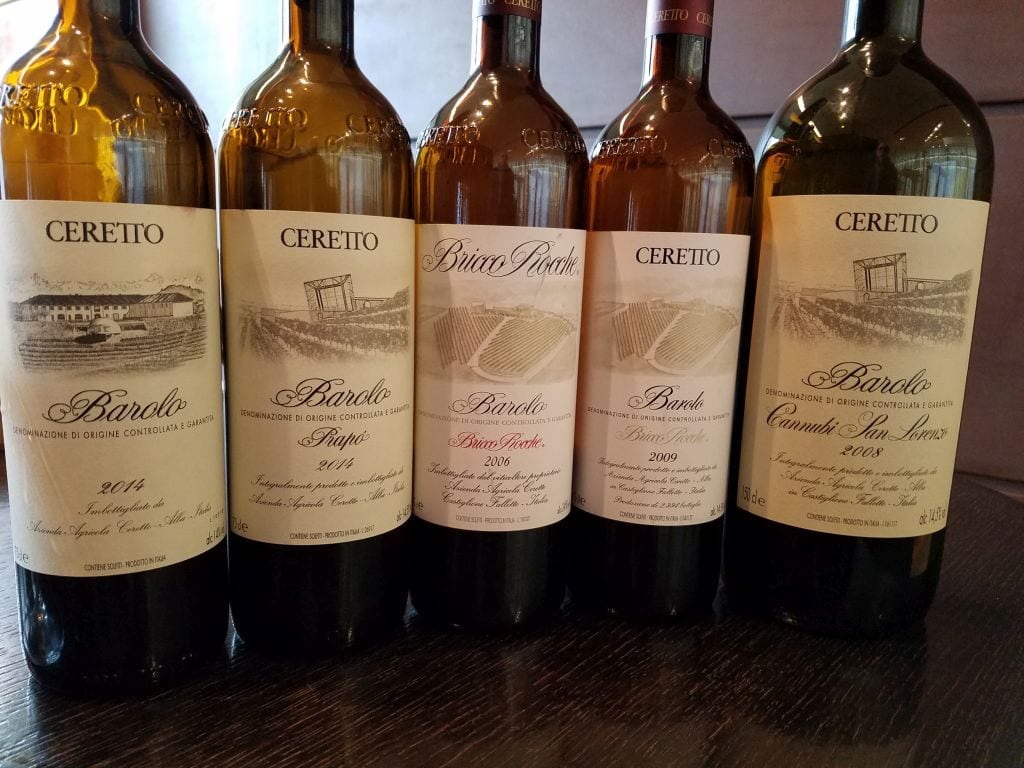In 2000, Ceretto installed a modern glass cube-shaped sculpture at the top of the Rocche vineyard in Castiglione Falletto, one of Barolo’s best communes. Its transparency allows you to see the surrounding vineyard where Ceretto grows the grapes for Bricco Rocche, its finest Barolo. It preceded The Grape, the glass dome that overhangs the vineyard in Ceretto’s Monsordo Bernardina Estate winery in San Cassiano (see last week’s article) by nine years. Both make striking visual statements not only about the wines’ transparencies, but also about Ceretto’s philosophy of blending art and wine.
In 2014, the Bricco Rocche (bricco is the name for the highest point of the vineyard in Piedmontese dialect) and Brunate vineyards were pummeled by hail, causing a total loss. But that didn’t stop winemaker Alessandro Ceretto from making a medium body, flavorful wine that year.
His 2014 Ceretto Barolo DOCG comes from nebbiolo grown in four of Barolo’s best communes: Castiglione Falletto, La Morra, Serrulunga d’Alba and Barolo—all within a 30-minute drive from each other. The wine’s mellow red fruit aroma is followed by ripe black-cherry fruit flavors bound with noticeable tannins. 89 points. Retail is $50 to $75.
Ceretto’s Prapo cru is a six-acre vineyard on the slopes of Serrulunga d’Alba. It escaped the hail storms, allowing Alessandro to make a pungent 2014 Ceretto Prapo Barolo.
Prapo’s French-oak barrel aging program results in stronger vanilla aroma and flavor than the other Ceretto barolos. Intermingled with the oak influence is blackcherry and raisin accents bound with firm, but not aggressive tannins. An hour or two of aeration will open this wine for current drinking. 90 points. Arriving in spring 2019, expect to pay from $100 to $120.
When it comes to older wines, only buy from retailers who have temperature-controlled storage. If you find such a source, here are a few older vintages to look for:
Barolo and Barbaresco are wines with decades, if not generations, of life. At my tasting, the 2006 Ceretto Bricco Rocche was generous with its black fruit and licorice aromas, and delicious mulberry, raspberry and fennel-like flavors. Its complexity is matched by a firm structure guaranteeing many more years of enjoyment. 94 points. Prices range from $120 to $188.
The 2009 vintage was warm throughout Europe, North America, and many other areas of the world. This climate condition is reflected in the soft mouthfeel and ripeness of the 2009 Ceretto Bricco Rocche. It has a great range of tasty red fruit and herbal aromas and flavors and is very drinkable. 92 points. If you own this 2009, now is a good time to enjoy it. It’s no longer in the retail market.
Last month, a bottle of 1995 Ceretto Bricco Rocche from my cellar reminded me of the elegance of Ceretto’s wines. This 23-year-old wine retained its color and vitality. Its fruit fragrance and flavor was lively and intertwined with herbal and tobacco accents. The tannins were present and supporting, forecasting many more years of life. It was rich without being heavy.
Last week’s article, which included notes on the 2015 Bricco Asili Barbaresco, motivated me to opened a bottle of the 1998 Ceretto Bricco Asili Barbaresco. Translucent and ethereal, its raspberry and cranberry flavors were seasoned with Chinese five spice-like aroma and flavor, and it retained refreshing acidity. It recalled the best characteristics of Grand Cru wines from Morey-Saint-Denis and Chambolle-Musigny. It was irresistible.
The third generation of Ceretto’s, Roberta, Lisa, Federico and Alessandro are continuing the vision set by their respective fathers, Bruno and Marcello with great wines from the best vineyards—all certified organic, and statements of culture and art. Excellence with style is their DNA.
Photos by John Foy










Leave A Comment